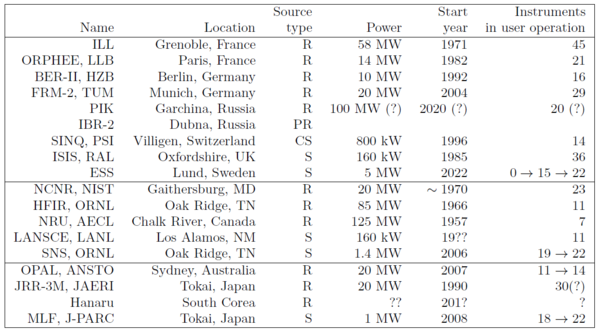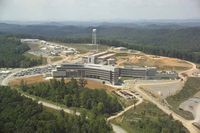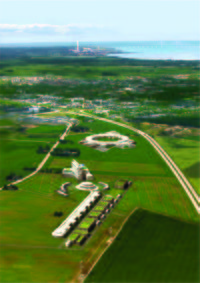Neutron sources: Difference between revisions
ucph>Tommy |
No edit summary |
||
| (3 intermediate revisions by the same user not shown) | |||
| Line 36: | Line 36: | ||
==Neutron scattering facilities== | ==Neutron scattering facilities== | ||
<figure id="fig:SNS"> [[File: | <figure id="fig:SNS"> [[File:Sns_0905.jpg | thumb | 200px | <caption>Aerial photo of the new American "Spallation Neutron Source", SNS. This is presently the world's most intense pulsed neutron facility.</caption>]] </figure> | ||
<figure id="fig:ESS"> [[File: | <figure id="fig:ESS"> [[File:ESS_airview1.jpg | thumb | 200px | <caption>Aerial photo of the town of Lund, looking towards Malmö and the Öresund Bridge, superimposed with a sketch of the X-ray synchrotron ring MAX-4 (under construction; first beam in 2016) and the neutron source ESS (foreground), which is designed to become the world leading neutron facility.</caption>]] </figure> | ||
A few dozens of neutron sources exist over the world, most of these in Europe, North America, and Asia. During the last decade, the leading sources have been those of ILL (F) and ISIS (UK). Many reactor sources built in the 1960's have exceeded their lifetime and are now closed. Notable close-downs of research reactors have been seen (in chronological order) at Brookhaven (US), Risø (DK), Studsvik (S), Jülich (D), Geestacht (D), and Kjeller (N). Also the spallation source IPNS (US) was recently closed down, and the reactor in Berlin and Paris are scheduled to close by end of 2019. | A few dozens of neutron sources exist over the world, most of these in Europe, North America, and Asia. During the last decade, the leading sources have been those of ILL (F) and ISIS (UK). Many reactor sources built in the 1960's have exceeded their lifetime and are now closed. Notable close-downs of research reactors have been seen (in chronological order) at Brookhaven (US), Risø (DK), Studsvik (S), Jülich (D), Geestacht (D), and Kjeller (N). Also the spallation source IPNS (US) was recently closed down, and the reactor in Berlin and Paris are scheduled to close by end of 2019. | ||
| Line 48: | Line 48: | ||
An even more ambitious project, the European Spallation Source (ESS) has been promoted over the last 20 years. In May 2009 it was decided to locate this source in Lund (S), and in July 2014 the construction work was initiated. A sketch of the ESS on the local site in Lund is given in <xr id="fig:ESS">Figure %i</xr><!--Fig.~\ref{fig:ESS}-->. The ESS project is backed up by 17 European countries, including Germany, UK, and France. According to the present plans, the first neutrons will be produced in late 2019<ref name="ess">See http://www.ess-scandinavia.eu</ref><!--\cite{ess}-->. | An even more ambitious project, the European Spallation Source (ESS) has been promoted over the last 20 years. In May 2009 it was decided to locate this source in Lund (S), and in July 2014 the construction work was initiated. A sketch of the ESS on the local site in Lund is given in <xr id="fig:ESS">Figure %i</xr><!--Fig.~\ref{fig:ESS}-->. The ESS project is backed up by 17 European countries, including Germany, UK, and France. According to the present plans, the first neutrons will be produced in late 2019<ref name="ess">See http://www.ess-scandinavia.eu</ref><!--\cite{ess}-->. | ||
<figtable id="tab:sources">[[File: | <figtable id="tab:sources">[[File:Table3.1.png | thumb | 600px | <caption>Characteristics of significant neutron sources worldwide, in operation or under construction. Reactor sources are marked by "R" and spallation sources by "S". The continuous spallation source at PSI is denoted "CS", and the pulsed reactor source in Dubna is denoted "PR". Data updated August 2012.</caption>]]</figtable> | ||
In <xr id="tab:sources">Table %i</xr><!--Table \ref{tab:sources}-->, we list the most important present neutron sources. European sources not listed include the smaller reactors in Delft (NL), Budapest (H), Rez (CZ), and Kjeller (N). A continuously updated list of neutron sources worldwide is found at collaborative home pages <ref name="NMI3">See the home page of the NMI3 project http://www.neutron-eu.net</ref><ref name="neutronsources">See the neutron facility collaboration home page at http://www.neutronsources.org/</ref><!--\cite{NMI3,neutronsources}-->. | In <xr id="tab:sources">Table %i</xr><!--Table \ref{tab:sources}-->, we list the most important present neutron sources. European sources not listed include the smaller reactors in Delft (NL), Budapest (H), Rez (CZ), and Kjeller (N). A continuously updated list of neutron sources worldwide is found at collaborative home pages <ref name="NMI3">See the home page of the NMI3 project http://www.neutron-eu.net</ref><ref name="neutronsources">See the neutron facility collaboration home page at http://www.neutronsources.org/</ref><!--\cite{NMI3,neutronsources}-->. | ||
Latest revision as of 16:55, 20 April 2020
We here describe how neutrons are produced, and where large-scale neutron scattering facilities are located around the world.
Producing neutrons
Neutrons can be produced in a number of ways, e.g. as by-products of cosmic radiation or radioactive decay of heavy nuclei. One often used laboratory neutron source is Californium, \(^{252}\)Cf, which emits neutrons by spontaneous fission (on average 3-4 neutrons per fission[1]). However, the \(^{252}\)Cf half life time of only ~2 years makes frequent source changes necessary. A more long lived laboratory source is the radium-beryllium source. Here, the radium decays spontaneously with a half life of ~1600 years according to
\begin{equation}\label{dummy172353487} {}^{226}{\rm Ra} \rightarrow {}^{222}{\rm Rn} + {}^4\alpha + Q , \end{equation}
with the heat release \(Q = 4.871\) MeV. In the presence of berylium, a neutron is released according to
\begin{equation}\label{dummy1700707666} {}^4\alpha + {}^9{\rm Be} \rightarrow n + {}^{12}{\rm C} . \end{equation}
More recently, neutrons have been produced in a laboratory experiment, using a pyroelectric crystal[2] or a high electrical field [3] to accelerate ions of deuterium (the heavy hydrogen isotope \(^2\)D) to high energies. This will produce neutrons through the reaction
\begin{equation}\label{dummy1166919397} {}^2{\rm D} + {}^2{\rm D} \rightarrow \, ^3{\rm He} + n + Q , \end{equation}
where \(Q\) is an excess energy of 3.27 MeV, of which around 2.5 MeV goes to the neutron.
As mentioned in the Introduction to neutron scattering page, and illustrated in the neutron production figure, neutron sources created for the purpose of materials investigation by scattering are either based upon chain reaction in a nuclear reactor or upon accelerator-driven spallation processes.
In nuclear reactors, neutrons are produced in the fission process
\begin{equation}\label{dummy229023259} {}^{235}{\rm U} + n \rightarrow \, {\rm D}_1 + {\rm D}_2 + \text{2-3}\, n + Q , \end{equation}
where D represent a range of daughter nuclei, and the released enrgy \(Q\) is of the order 200 MeV. A \({}^{235}\)U fission typically yields 1.4 excess neutron per nuclear process[4]. Research reactors with compact cores are used for neutron scattering purposes, rather than the more abundant nuclear power plants that have much larger cores. Reactor sources usually emit a continuous stream of neutrons, except for the remarkable pulsed reactor source in Dubna (RUS), where two large wheels drive the neutron reflectors in a way, so that criticality is reached only in short bursts.
A spallation source is driven by a proton accelerator, which emits protons with energies in the range 1-3 GeV. The protons collide with heavy, neutron-rich nuclei, which are destroyed in the process to many smaller fragments, releasing of the order 10-20 neutrons per proton. Spallation sources are typically pulsed, but can also be pseudo-continuous, as is the case at SINQ at the Paul Scherrer Institute, PSI (CH).
Neutron scattering facilities
A few dozens of neutron sources exist over the world, most of these in Europe, North America, and Asia. During the last decade, the leading sources have been those of ILL (F) and ISIS (UK). Many reactor sources built in the 1960's have exceeded their lifetime and are now closed. Notable close-downs of research reactors have been seen (in chronological order) at Brookhaven (US), Risø (DK), Studsvik (S), Jülich (D), Geestacht (D), and Kjeller (N). Also the spallation source IPNS (US) was recently closed down, and the reactor in Berlin and Paris are scheduled to close by end of 2019.
To compensate for this loss, and to bring progress to neutron scattering science, new advanced neutron sources are being built and commisioned. It is worth mentioning the new reactors FRM-2 at Technical University of Munich (D), OPAL at ANSTO in Sydney (AUS), and CARR at CIAE (China). In addition, major upgrades are being performed at ILL.
Most important for the future are, however, the spallation sources. The second target station at the ISIS spallation source has almost doubled the number of instruments at this facility. Even more impressive are, however, the new powerful spallation sources SNS, Oak Ridge, Tennessee[5] (first neutrons April 2006; Figure xx--CrossReference--fig:SNS--xx) and J-PARC, Tokai, Japan[6] (first neutrons May 2008; re-opened December 2011 after earthquake/tsunami damage).
An even more ambitious project, the European Spallation Source (ESS) has been promoted over the last 20 years. In May 2009 it was decided to locate this source in Lund (S), and in July 2014 the construction work was initiated. A sketch of the ESS on the local site in Lund is given in Figure xx--CrossReference--fig:ESS--xx. The ESS project is backed up by 17 European countries, including Germany, UK, and France. According to the present plans, the first neutrons will be produced in late 2019[7].

In Table xx--CrossReference--tab:sources--xx, we list the most important present neutron sources. European sources not listed include the smaller reactors in Delft (NL), Budapest (H), Rez (CZ), and Kjeller (N). A continuously updated list of neutron sources worldwide is found at collaborative home pages [8][9].
The future may see even other types of sources, the so-called compact neutron sources, which are accelerator driven, but somewhat smaller than the large spallation sources present today. It is under discussion to build such sources in a number of countries, for example France and Germany. These sources could play the same role in the neutron science landscape as the low-to-medium power national sources have done during the 20th century.
Access to neutron sources
Research centers for neutron scattering are typically nationally funded facilities; except ILL and ESS that are European. The most common way of utilizing these facilities is when research groups propose scientific projects to be performed at particular instruments on the facility. These proposals are then considered by an independent expert panel, which will advice the facility directors on the quality and scientific urgency of proposals, leading to a selection of successful proposals.
Most facilities have deadline for proposals twice per year, and access (or beam time) is often allocated 3-4 months after the deadline for the half-year period starting 2-3 months later. Hence, the actual experiment is typically performed 6-12 months after the proposal submission. However, most facilities have other ways of allocating beam time for particularly urgent experiments.
- ↑ W.W.T Crane, G.H. Higgins, and S.G. Thompson. Phys. Rev., vol. 97, p. 242 (1955)
- ↑ B. Naranjo and J.K. Gimzewski and S. Putterman, Nature, vol. 434, p. 1115 (2005)
- ↑ See the home page http://www.aip.org/tip/INPHFA/vol-9/iss-6/p22.html
- ↑ J. Duderstadt and L. Hamilton, Nuclear Resactor Analysis (Wiley, 1976)
- ↑ See http://www.sns.gov
- ↑ See http://j-parc.jp/MatLife/en/index.html
- ↑ See http://www.ess-scandinavia.eu
- ↑ See the home page of the NMI3 project http://www.neutron-eu.net
- ↑ See the neutron facility collaboration home page at http://www.neutronsources.org/

